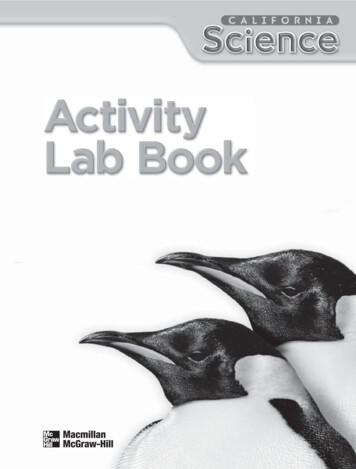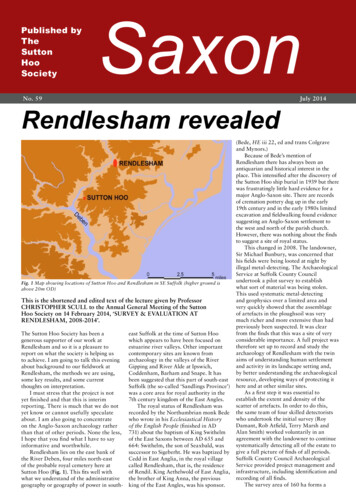
Transcription
All photographs are by Macmillan/McGraw-Hill (MMH) except as noted below.Cover Photos: (bkgd) Natural Selection Stock Photography; (inset) Pete Oxford/Steve Bloom Images/Alamy.Science Content Standards for California Public Schools reproduced by permission, California Department of Education, CDEPress, 1430 N Street, Suite 3207, Sacramento, CA 95814.Published by Macmillan/McGraw-Hill, of McGraw-Hill Education, a division of The McGraw-Hill Companies, Inc.,Two Penn Plaza, New York, New York 10121.Copyright by Macmillan/McGraw-Hill. All rights reserved. No part of this publication may be reproducedor distributed in any form or by any means, or stored in a database or retrieval system, without the prior written consentof The McGraw-Hill Companies, Inc., including, but not limited to, network storage or transmission, or broadcast fordistance learning.Printed in the United States of America1 2 3 4 5 6 7 8 9 024 09 08 07 06A
ContentsLIFE SCIENCEChapter 1Adaptations in Land Environments. . . . . . . . . . . . . . . . . . . . . . 1Chapter 2Adaptations in Water Environments . . . . . . . . . . . . . . . . . . . . 33Chapter 3Environments Change . . . . . . . . . . . . . . . . . . . . . . . . . . . . . . . . 53EARTH SCIENCEChapter 4Our Earth, Sun, and Moon . . . . . . . . . . . . . . . . . . . . . . . . . . . . 73Chapter 5The Solar System . . . . . . . . . . . . . . . . . . . . . . . . . . . . . . . . . . . . 93PHYSICAL SCIENCEChapter 6Matter . . . . . . . . . . . . . . . . . . . . . . . . . . . . . . . . . . . . . . . . . . . . .113Chapter 7Energy . . . . . . . . . . . . . . . . . . . . . . . . . . . . . . . . . . . . . . . . . . . . 133Chapter 8Light . . . . . . . . . . . . . . . . . . . . . . . . . . . . . . . . . . . . . . . . . . . . . . 153Everyday Science Activities . . . . . . . . . . . . . . . . . . . . . . . . . . . . . . . . . . . . . 173 Macmillan/McGraw-HillLearning Labs . . . . . . . . . . . . . . . . . . . . . . . . . . . . . . . . . . . . . . . . . . . . . . . . . 197California science standards are noted at the top of activity pages. For the text of thestandards, please refer to the Reference section of the California Science Student Edition.Activity Lab Bookiii
NameDateExploreCalifornia Standard3 IE 5.e.What do plants need to live?Form a HypothesisDo plants need light? Do they need water?Write a hypothesis.Materials 4 identicalplants measuring cupand waterTest Your HypothesisLabel four identical plants as shown.Observe How do the plants look? Record your observations ina chart.PlantsDay 1Day 4Day 8Day 12Light and WaterLight and No WaterNo Light and Water Macmillan / McGraw-HillNo Light and No Water!Put the plants labeled No Light in a dark place. Put the plantslabeled Light in a sunny place. Water the plants labeled Waterevery few days."Predict What do you think will happen to each plant?Chapter 1 Adaptations in Land EnvironmentsActivity Lab BookUse with Lesson 1Living Things and Their Needs1
Explore#NameDateCollect Data Look at the plants every few days. Record yourobservations in your chart.Draw Conclusions Analyze Data Which plant grew the most after two weeks?Which plant looks the healthiest?%What do plants need to live?Explore MoreExperiment What else do plants need to live?Inquiry: Open Think of your own question about what plants need tolive.My question is: Macmillan / McGraw-HillHow I can test it:My results are:2Chapter 1 Adaptations in Land EnvironmentsActivity Lab BookUse with Lesson 1Living Things and Their Needs
NameAlternativeExploreDatePicturing plant needsProcedureThe first plant has received regular water andsunlight. The second plant received regularwater but no sunlight. The last plant receivedregular sunlight but no water.Observe Describe how each plant looks.Materials 3 plants orphotos of plantsthat are thesame heightand typePlant 1Plant 2Plant 3 Macmillan / McGraw-HillDraw Conclusions What do plants need in order to live?Chapter 1 Adaptations in Land EnvironmentsActivity Lab BookUse with Lesson 1Living Things and Their Needs3
Quick LabNameDateObserve plant partsGet two plants to observe.Observe Look at the parts of each plant. Does each plant haveroots?How about stems and leaves?!Record Data Use pictures and words to describe each ompare How are the parts of these plants alike? How are theydifferent?Chapter 1 Adaptations in Land EnvironmentsActivity Lab BookUse with Lesson 1Living Things and Their Needs
NameClassifyDateFocus onSkillsCalifornia Standard3 IE 5.e.Earth is a big place. Millions of living things find homes in a widerange of environments around our planet. With all these livingthings and all these different environments, what can scientists doto understand life in our world? One thing they do is compare andclassify living things and environments.Learn ItWhen you classify, you put things into groups that are alike.Classifying is a useful tool for organizing and analyzing things.It is easier to study a few groups of things that are alike thanmillions of individual things.Try ItYou learned that scientists classify Earth’s environments intobiomes. They classify animals, too. Can you?To start you need to come up with a rule. What will you use forgrouping the animals shown on page 7? Let’s try wings.Then use your rule to put the animals into groups. Which animalshave wings? Which animals do not? Make a T-chart to show yourgroups.Chapter 1 Adaptations in Land EnvironmentsActivity Lab BookUse with Lesson 1Living Things and Their Needs5
Focus onSkillsNameNo Wings Macmillan / McGraw-HillWingsDate6Chapter 1 Adaptations in Land EnvironmentsActivity Lab BookUse with Lesson 1Living Things and Their Needs
DateFocus onSkills Macmillan / McGraw-HillNameChapter 1 Adaptations in Land EnvironmentsActivity Lab BookUse with Lesson 1Living Things and Their Needs7
Focus onSkills!NameDateApply ItClassify these animals using a different rule.No Tails Macmillan / McGraw-HillTails8Chapter 1 Adaptations in Land EnvironmentsActivity Lab BookUse with Lesson 1Living Things and Their Needs
NameDateWhat adaptations help plantssurvive in a desert?Make a PredictionWhy can some plants live in dryenvironments? How do special structureshelp them survive? Write a prediction.ExploreCalifornia Standard3 IE 5.e.Materials scissors two plants hand lensTest Your PredictionObserve Use a hand lens to observe each plant. Whatstructures do they have? What are their leaves like? What aretheir stems like?Record Data Make a chart to record your observations. Usewords and pictures.Observe Cut a leaf from each plant in half. Use a hand lens tolook at the leaves. What are the leaves like inside? Macmillan / McGraw-Hill!Chapter 1 Adaptations in Land EnvironmentsActivity Lab BookUse with Lesson 2Life in the Desert9
ExploreNameDateDraw Conclusions"Compare How are the plants alike? How are they different?#Infer What special structures help the desert plant survive in ahot, dry environment?Explore MoreExperiment Put a leaf from each plant on the windowsill. How do theleaves change?Inquiry: Open Think of your own question about what desert plantsneed to live.My question is: Macmillan / McGraw-HillHow I can test it:My results are:10Chapter 1 Adaptations in Land EnvironmentsActivity Lab BookUse with Lesson 2Life in the Desert
NameDateAlternativeExploreWhich plant can survivebetter in the desert?ProcedureRecord Data Look at the plants in thephotographs. Describe the leaves of thetwo plants in a chart.Materials photographs ofAfrican violetand jade plants paper towels Macmillan / McGraw-HillMake a Model Fold a paper towel in half so that you have twolayers. Fold another paper towel so that you have eight layers.Wet both paper towels.!Observe Place both paper towels in a sunny window for anhour. Describe your observations."Compare Which paper towel is like the leaves of an Africanviolet plant? Which paper towel is like the leaves of the jadeplant?#Draw Conclusions Which plant will survive better in the desert?How does this plant’s leaves help it survive?Chapter 1 Adaptations in Land EnvironmentsActivity Lab BookUse with Lesson 2Life in the Desert11
Quick LabNameDateDesert adaptationsMake a Model Wet two paper towels. Then wrap one inwax paper. This models a plant that has waxy skin. Use theuncovered towel to model a plant that does not have waxy skin.Place your models in a sunny window.Compare How do the paper towels feel later in the day?"Draw Conclusions How does waxy skin help desert plantssurvive? Macmillan / McGraw-Hill!12Chapter 1 Adaptations in Land EnvironmentsActivity Lab BookUse with Lesson 2Life in the Desert
NameBe aScientistDateCalifornia Standard3 IE 5.c., 3 IE 5.e.How does camouflage helpsome animals survive?MaterialsForm a HypothesisHow does camouflage help animals stay safe?Record your hypothesis. Start with “If ananimal has camouflage, then . . .” yellow paper brown paper stop watchTest Your HypothesisCut out 20 yellow circles and 20 brown circles.Experiment Spread out the circles on the paper. Then ask aclassmate to pick up as many circles as he can in 10 seconds.!Record Data How many of each color circle did your classmatepick up? Use a chart to record the results. Macmillan / McGraw-HillClassmate’s NameYellow CirclesBrown CirclesRepeat steps 1 and 2 with two other classmates.Chapter 1 Adaptations in Land EnvironmentsActivity Lab BookUse with Lesson 2Life in the Desert13
Be aScientistNameDateDraw ConclusionsAnalyze Data Did your classmates pick up more yellow orbrown circles? Which circles were harder to find?#How might camouflage help animals survive? Macmillan / McGraw-Hill"14Chapter 1 Adaptations in Land EnvironmentsActivity Lab BookUse with Lesson 2Life in the Desert
NameDateBa aScientistHow do pale colors helpsome animals survive?Form a HypothesisPale body coverings help desert animals staycool. Why is this true? Write a hypothesis.Materials white beans black beans twothermometersTest Your HypothesisDesign a plan to test your hypothesis. Use the materials shown.Write the steps you plan to follow.!"Draw Conclusions Macmillan / McGraw-HillDid your results support your hypothesis? Why or why not? Shareyour results with your classmates.Chapter 1 Adaptations in Land EnvironmentsActivity Lab BookUse with Lesson 2Life in the Desert15
Be aScientistNameDateInquiry: Open What other questions do you have about desert plantsand animals? Talk with your classmates about questions you have.How might you find the answers to your questions?Remember to follow the steps of the scientific process.Ask a QuestionForm a HypothesisTest Your Hypothesis Macmillan / McGraw-HillDraw Conclusions16Chapter 1 Adaptations in Land EnvironmentsActivity Lab BookUse with Lesson 2Life in the Desert
NameDateWhy do some animals livein a grassland?Make a PredictionWhy do animals live in grassland? Write yourprediction.ExploreCalifornia Standard3 IE 5.d.Materials index card markers orpencils clear tapeTest Your PredictionUse research materials to learn about an animal that lives in agrassland biome. Macmillan / McGraw-HillRecord Data Make a picture fact card for your animal. Drawor tape a picture of the animal on the card and label it. On theother side, write the name of the grassland biome and list thethree facts you learned.Chapter 1 Adaptations in Land EnvironmentsActivity Lab BookUse with Lesson 3Life in the Grassland17
ExploreNameDateDraw Conclusions#What are some important things that animals find in grasslandbiomes?Explore MoreWhat would happen after a month of no rain in the grasslands? Howdoes rainfall affect grassland animals?Inquiry: OpenMy question isHow I can test it: Macmillan / McGraw-HillMy results are:18Chapter 1 Adaptations in Land EnvironmentsActivity Lab BookUse with Lesson 3Life in the Grassland
NameDateWhich adaptations allowgrassland animals to livewithin their environment?ProcedureCompare Sort animals by theiradaptations.AlternativeExploreMaterials fact sheetsabout grasslandanimals encyclopedia/Internet Macmillan / McGraw-HillDraw ConclusionsChapter 1 Adaptations in Land EnvironmentsActivity Lab BookUse with Lesson 3Life in the Grassland19
Quick LabNameDateHow grasses growPut some sand or pebbles in the bottomof a plastic cup. Add potting soil almostto the top. Sprinkle grass seeds over thesoil. Water the soil. Place the cup in asunny spot.Materials sand or pebbles potting soil grass seedsRecord Data Record when you plantedthe grass on a calendar. paper cups water!Observe Check your grass seeds eachday. Keep the soil moist."Compare Carefully uproot some grass. Measure the grass andthe roots. Which is longer? Macmillan / McGraw-Hill centimeterrulers20Chapter 1 Adaptations in Land EnvironmentsActivity Lab BookUse with Lesson 3Life in the Grassland
NameDateWill a plant growtoward light?ExploreCalifornia Standard3 IE 5.d.MaterialsMake a PredictionPlants need sunlight to survive. If somethingis blocking the light, how will a plant respond? scissors large shoebox heavycardboard masking tapeTest Your Prediction small pottedplant (fastgrowing)Cut a hole in one end of a shoe box.Cut two dividers from the cardboard astall as the shoe box but an inch shorter than its width.!Tape the dividers upright along the inside of the box."Put your plant in the end of the box opposite the hole. Then putthe lid on the box and turn the hole toward bright sunlight.Draw Conclusions Macmillan / McGraw-HillHow does the plant get the light it needs?Chapter 1 Adaptations in Land EnvironmentsActivity Lab BookUse with Lesson 4Life in the Forest21
ExploreNameDateExplore MoreObserve Observe plants around your school. Are they getting directsunlight? Or are they in shade from a tree or building? How well havethey adapted to their environment?Inquiry: Open Ask students to think about the other aspects oftheir environment to which
or distributed in any form or by any means, or stored in a database or retrieval system, without the prior written consent of The McGraw-Hill Companies, Inc., including, but not limited to, network storage or transmission, or broadcast for











